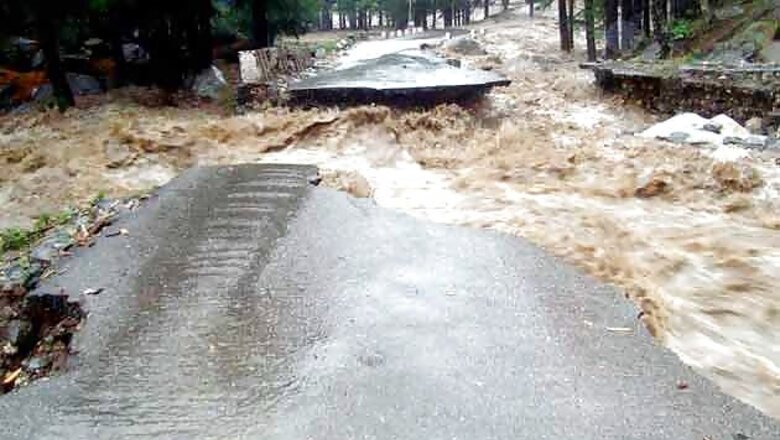
views
Notwithstanding a "mammoth" exercise to rehabilitate devastated areas, it will take a year or even more to drag Uttarakhand out of the effects of the June calamity as vagaries of nature and unique geographical conditions have made the exercise difficult, Disaster Management Centre chief Piyush Rautela said on Wednesday.
Given the scale of the tragedy which was of a pan-Indian nature with people from all over the country being killed and hundreds of villages swept away, it will be naive to bind the reconstruction and rehabilitation exercise in Uttarakhand in a specific time-frame, he told.
It is over two months since the flashfloods and landslides left a trail of death and devastation in the state in mid June this year but life is still waiting to come back on track in the affected areas with 10234 families in 366 villages yet to be rehabilitated and 335 roads including major motor roads in the worst hit Chamoli, Rudraprayag, Uttarkashi and Pithoragarh districts still blocked at places making it difficult to take relief material to people, an official data said.
1967 roads are open to traffic but only on a temporary basis.
However, the state government is hopeful that the major highways including Rishikesh-Badrinath, Rishikesh-Gangotri and Rishikesh-Yamunotri highways are opened within the stipulated deadline of September 30.
The BRO and PWD personnel are on the job trying to restore the heavily damaged road network within the stipulated time frame but much will depend on the frequency of rainfall which keeps hampering the operations every now and then, Rautela said.
"Despite the best of intentions of the personnel engaged in reconstruction efforts nothing can be expected overnight. The weather is often bad and the hilly terrain in which the roads and bridges are being rebuilt don't let the operations go smoothly," he said.
However, he said given the difficult terrain and monsoon vagaries the job being done is really commendable.In a scenario like this, it is not an easy job to open 1967 of a total of 2302 roads damaged in the calamity in just over two months, he said.
The work of our personnel becomes even more commendable when considered in the light of the fact that reconstruction of roads and bridges could begin in a full-fledged manner only after the prolonged evacuation exercise was completed," Rautela said.
However, putting life back on track, especially in the higher reaches of the state's hill districts which bore the brunt of the calamity is going to be a long drawn process.
"There can't be any shortcut to complete rehabilitation of the people rendered homeless by the calamity.Look at the people displaced by the Tehri dam. Despite decades after the dam was built they are yet to be rehabilitated," the DMMC Executive Director said adding the process always takes long as several factors are involved.
"It is not like we have funds and there is a place where a few hundred people who have lost their homes have to be moved.
"We must bear in mind the fact that those who lost their homes and villages in the tragedy were living there for generations. They had their roots and businesses there.Not all of them may be willing to be relocated due to their emotional affiliations with the places they lost," the official said.
Terming rehabilitation as a comprehensive process, he said it is too early to conclude that the state government is taking too long to rehabilitate people in the affected areas.
90 per cent of the compensation claims of people who lost their kin in the tragedy have been settled which is no mean achievement in itself but creation of a new Uttarakhand, breathing life back into the tourism sector, the mainstay of the state's economy is definitely an onerous task which will take time to be accomplished, he said.
"You may rebuild the roads, the guest houses washed away in the floods in a few months time but how can you ensure that the confidence of visitors returns in a few months.It will come back at its own pace and until that comes the tourism sector can't be revived," Rautela said.
Rautela said the damaged tourist infrastructure can be recreated in a few months but not the confidence of tourists which took a beating after the deluge hit the state damaging vast tracts of land in Kedarnath valley including the tourist infrastructure close to the Himalayan shrine.
There has been bulk cancellation of bookings in hotels of Nainital and Mussoorie despite the fact that they were comparatively less affected.
Attributing this to a fear psychosis that has gripped potential visitors, the DMMC Executive Director said efforts are on at various levels to dispel such fear but it can't be said how long it will take to accomplish this task.
"People are afraid of coming to Uttarakhand.Hotels and guest houses in Mussoorie and Nanintal have had to face bulk cancellation of bookings this monsoon.Efforts are under way to dispel their apprehensions as areas like Nainital, Ranikhet and Mussoorie are largely unaffected by the tragedy and there is no risk involved in visiting them.
"But rebuilding confidence among potential visitors and restoring tourist traffic to the state is a time taking process. Nothing will happen overnight," Rautela said.
A report from ASSOCHAM which has placed a demand of Rs 10000 crore before the Centre for the rehabiliation and reconstruction of affected areas in the disaster-hit state said damage to the tourism sector alone in the state would cause a loss of over Rs 5000 crore to the state GDP.
"Loss to the state GDP would be to the tune of over Rs 5000 crore owing to the decreased contribution from tourism and trade, hotel and restaurant segments," ASSOCHAM Secretary General D S Rawat said.
It would be a major setback as tourism sector accounts for 1/4 of Uttarakhand's state domestic product with the three worst hit districts of Rudraprayag, Chamoli and Uttarkashi accounting for about 19 per cent of the state's total tourist inflows, Rawat said citing the findings of a recent survey carried out by ASSOCHAM.
The tourism sector wouls also witness a direct employment loss of about 1,80,000 people becoming employed for six months in the current year.



















Comments
0 comment